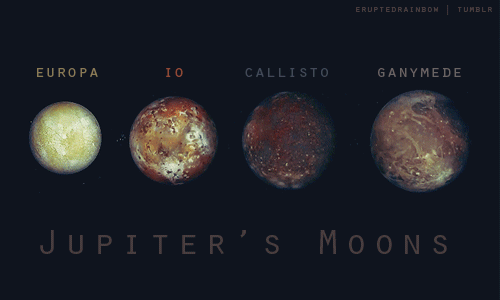Jupiter and the Galilean Moons
The planet Jupiter has been known ever since anyone looked at the sky.
It is a bright object which moves slowly across the starry background, taking about 12 years to track all the way around.
Through a telescope it looks spectacular, and even better in pictures taken by space probes.

In this picture, the coloured belts of clouds are clear, with a black shadow of one of Jupiter's moons.
Small telescopes show four moons, but there are also lots of smaller moons orbiting Jupiter.
The four larger moons were first seen by Galileo when he first used a newly-invented telescope in 1610, so they are called the Galilean moons.

The four Galilean moons were just small fuzzy objects until space probes visited Jupiter and showed that they are all different.

Io has active volcanoes, Europa has an icy crust which may cover an ocean, Ganymede and Callisto are made of rock and ice, but Callisto has far more craters.
It is a bright object which moves slowly across the starry background, taking about 12 years to track all the way around.
Through a telescope it looks spectacular, and even better in pictures taken by space probes.

In this picture, the coloured belts of clouds are clear, with a black shadow of one of Jupiter's moons.
Small telescopes show four moons, but there are also lots of smaller moons orbiting Jupiter.
The four larger moons were first seen by Galileo when he first used a newly-invented telescope in 1610, so they are called the Galilean moons.
The four Galilean moons were just small fuzzy objects until space probes visited Jupiter and showed that they are all different.

Io has active volcanoes, Europa has an icy crust which may cover an ocean, Ganymede and Callisto are made of rock and ice, but Callisto has far more craters.